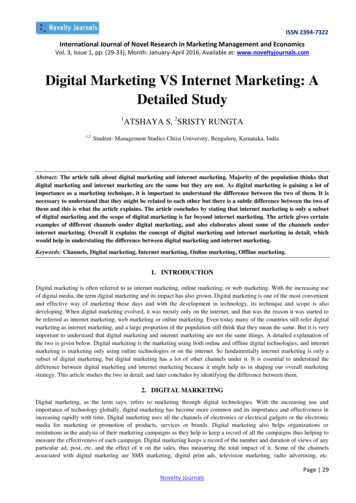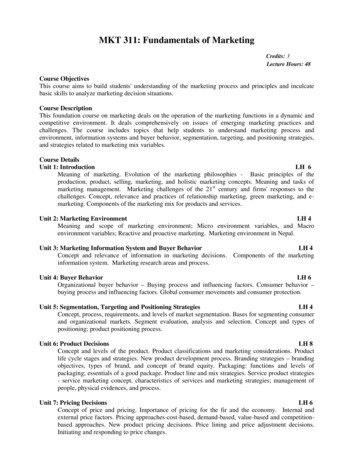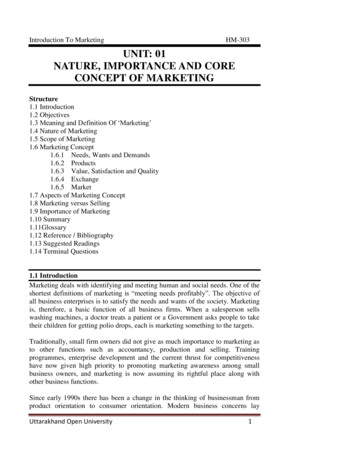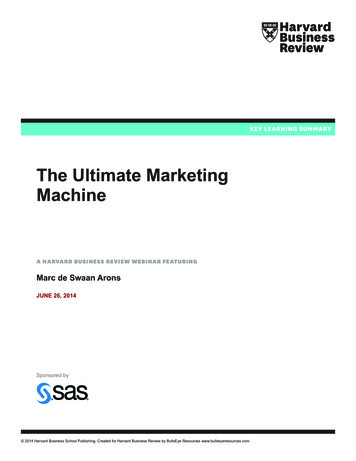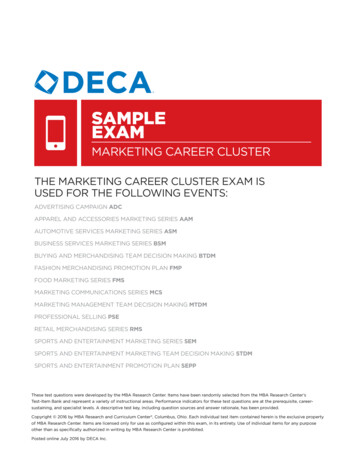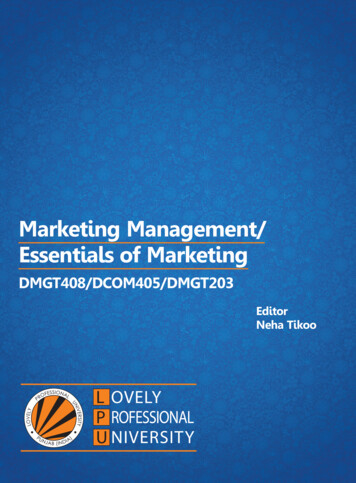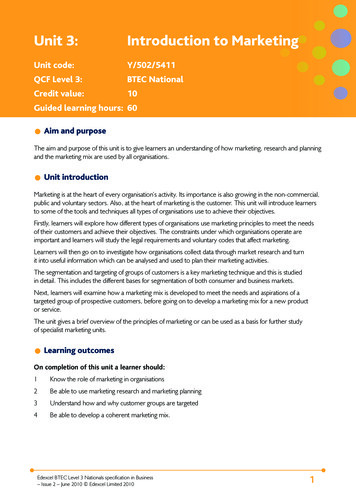
Transcription
Unit 3:Introduction to MarketingUnit code:Y/502/5411QCF Level 3:BTEC NationalCredit value:10Guided learning hours: 60Aim and purposeThe aim and purpose of this unit is to give learners an understanding of how marketing, research and planningand the marketing mix are used by all organisations.Unit introductionMarketing is at the heart of every organisation’s activity. Its importance is also growing in the non-commercial,public and voluntary sectors. Also, at the heart of marketing is the customer. This unit will introduce learnersto some of the tools and techniques all types of organisations use to achieve their objectives.Firstly, learners will explore how different types of organisations use marketing principles to meet the needsof their customers and achieve their objectives. The constraints under which organisations operate areimportant and learners will study the legal requirements and voluntary codes that affect marketing.Learners will then go on to investigate how organisations collect data through market research and turnit into useful information which can be analysed and used to plan their marketing activities.The segmentation and targeting of groups of customers is a key marketing technique and this is studiedin detail. This includes the different bases for segmentation of both consumer and business markets.Next, learners will examine how a marketing mix is developed to meet the needs and aspirations of atargeted group of prospective customers, before going on to develop a marketing mix for a new productor service.The unit gives a brief overview of the principles of marketing or can be used as a basis for further studyof specialist marketing units.Learning outcomesOn completion of this unit a learner should:1Know the role of marketing in organisations2Be able to use marketing research and marketing planning3Understand how and why customer groups are targeted4Be able to develop a coherent marketing mix.Edexcel BTEC Level 3 Nationals specification in Business– Issue 2 – June 2010 Edexcel Limited 20101
Unit content1 Know the role of marketing in organisationsRole: overall concept; marketing definitionsObjectives: private sector aims and objectives (survival, growth); public and voluntary sector aims andobjectives (service provision, growth of range of provision, cost limitation, meeting quality standards);marketing objectives, eg market leadership, brand awareness, perceptions of customers or users; linkbetween organisational objectives and marketing objectivesTechniques: growth strategies (diversification, product development, market penetration or marketdevelopment, Ansoff’s Matrix); survival strategies; branding (importance in influencing buyer behaviour,brand building, positioning, brand extension); relationship marketing (definition, difference betweentransactional marketing and relationship marketing, value of lifetime customer)Limitations and constraints: legal (Sale of Goods Act 1979, The Consumer Protection from Unfair TradingRegulations 2008, Consumer Credit Acts 1974 and 2006, Consumer Protection (Distance Selling)Regulations, Data Protection Act 1998); voluntary, eg Code of Advertising Practice and AdvertisingStandards Authority; pressure groups and consumerism; acceptable language2 Be able to use marketing research and marketing planningMarketing research: qualitative; quantitative; primary internal/external research; secondary internal/external research; uses (reduce risk in decision making, measure progress over time); limitations(cost effectiveness, validity of data collected)Marketing planning: marketing planning process model (audit with PESTLE (political, economic, social,technological, legal and environmental external factors); SWOT (internal strengths and weaknesses,external opportunities and threats); set SMART (specific, measurable, achievable, resourced, time-bound)objectives; determine strategy and tactics, implement changes; evaluate)3 Understand how and why customer groups are targetedIdentifying customers in consumer markets: difference between customers, consumers and buyers;importance of identifying who has influence over purchasing decisionsMarket segmentation: importance; bases for segmentation of consumer markets (geographic, demographic,psychographic, lifestyle); uses of geo-demographic systems to identify and reach target groups eg ACORN,MOSAIC; reasons for choice of target group (accessibility, current and future prospects of group ascustomers, profitability; ability to service customer group, fit with organisation’s mission)Identifying customers in business to business markets: decision making unit (DMU)Market segmentation: bases for segmentation of business markets (size, region, value, public/private/voluntary sector, product, industry); benefits for different members of the DMU, eg cost benefits, ongoingrelationships, security of supply2Edexcel BTEC Level 3 Nationals specification in Business– Issue 2 – June 2010 Edexcel Limited 2010
4 Be able to develop a coherent marketing mixMarketing mix: 4 P’s – product; price; place; promotion; objectives of developing mix (support brandbuilding, satisfy needs and aspirations of targeted group of customers); importance of need for cohesionof different elements of the marketing mixProduct: product range; benefits versus features of product or service for targeted customers; conceptof product life cyclePrice: pricing strategies (premium pricing, penetration pricing, economy pricing, price skimming, psychologicalpricing, captive product pricing, product line pricing)Place: distribution; online and/or physical presencePromotion: promotional mix (advertising (different media, online techniques), personal selling, public relations,sales promotion)Edexcel BTEC Level 3 Nationals specification in Business– Issue 2 – June 2010 Edexcel Limited 20103
Assessment and grading criteriaIn order to pass this unit, the evidence that the learner presents for assessment needs to demonstrate thatthey can meet all the learning outcomes for the unit. The assessment criteria for a pass grade describe thelevel of achievement required to pass this unit.Assessment and grading criteriaTo achieve a pass grade theevidence must show that thelearner is able to:To achieve a merit grade theevidence must show that, inaddition to the pass criteria,the learner is able to:To achieve a distinction gradethe evidence must show that,in addition to the pass andmerit criteria, the learner isable to:P1describe how marketingtechniques are used tomarket products in twoorganisations[IE]M1 compare marketingD1techniques used in marketingproducts in two organisationsevaluate the effectivenessof the use of techniques inmarketing products in oneorganisationP2describe the limitations andconstraints of marketing[RL]P3describe how a selectedorganisation uses marketingresearch to contribute to thedevelopment of its marketingplansM2 explain the limitationsD2of marketing researchused to contribute to thedevelopment of a selectedorganisation’s marketing plansmake justifiedrecommendations forimproving the validityof the marketing researchused to contribute to thedevelopment of a selectedorganisation’s marketingplans.P4use marketing research formarketing planningP5explain how and why groupsof customers are targeted forselected productsP6develop a coherentmarketing mix for a newproduct or service.[CT]M3 develop a coherent marketingmix that is targeted at adefined group of potentialcustomers.PLTS: This summary references where applicable, in the square brackets, the elements of the personal,learning and thinking skills applicable in the pass criteria. It identifies opportunities for learners to demonstrateeffective application of the referenced elements of the skills.Key4IE – independent enquirersRL – reflective learnersSM – self-managersCT – creative thinkersTW – team workersEP – effective participatorsEdexcel BTEC Level 3 Nationals specification in Business– Issue 2 – June 2010 Edexcel Limited 2010
Essential guidance for tutorsDeliveryFor learning outcome 1, it is important to address the assumption many learners may have that marketing is merelyadvertising. In fact, it is a more complex activity and this unit gives a deeper understanding of the whole marketingprocess. The business purposes and strategic planning covered in the Unit: The Business Environment, may berevisited to show the links and differences between organisational and marketing objectives. Next, learnersmove on to an overview of key marketing principles. Learners could apply Ansoff’s matrix to a simple casestudy, an organisation they are familiar with, or to a business game. Branding and relationship marketingprovide opportunities for linking with learners’ existing knowledge as consumers. Learners move onto thelegislation which constrains marketers. The principles of the legislation should be covered and then appliedto situations which may be familiar to learners as customers.Learning outcome 2 includes an introduction to marketing research, and learners may enjoy conducting theirown research. However, if there is insufficient time for this, an exercise where learners plan research to meetspecified needs could be used to consolidate the teaching. Marketing research is covered in a separate specialistunit. The rest of the outcome is about the marketing planning process and delivery would be enhanced iflearners could play the role of business-decision makers in a business game or a detailed case study.Learning outcome 3 is about segmenting markets and targeting groups of potential customers. Learnersmay find it interesting to examine the geo-demographic descriptors for different local postcodes. A practicalexercise where pairs of learners define target markets for different products could be used. Learners shouldalso consider the different segmentation and targeting methods used in business and again, a targeting exercisecould be useful.In learning outcome 4 learners need to understand about the principles of a coherent marketing mix and thereare many examples of products where the marketing mix is targeted to the younger consumer. Learners couldanalyse all aspects of the marketing mix and suggest how it has been designed to appeal to the target group.This may be clearer if learners also examine products targeted to a different group. For the assessment of thisoutcome, learners need to design their own marketing mix, so it would be useful for learners to be given astep-by-step analysis of the process and perhaps a small group exercise in designing a marketing mix.Edexcel BTEC Level 3 Nationals specification in Business– Issue 2 – June 2010 Edexcel Limited 20105
Outline learning planThe outline learning plan has been included in this unit as guidance and can be used in conjunction with theprogramme of suggested assignments.The outline learning plan demonstrates one way in planning the delivery and assessment of this unit.Topic and suggested assignments/activities and/assessmentIntroduction to unit, structure of the programme and basic definitions of marketing and its prevalence in businessPair exercise where learners examine their recent transactions with organisations, the role marketing playedand the organisations’ marketing and organisational objectivesIntroduction to use of marketing objectives to achieve organisational objectives and Ansoff’s MatrixPair exercise on how Ansoff’s Matrix could be used in own institutionIntroduction to consumer legislation. Whole classSmall groups – analyse case studies from consumer organisation on breaches of consumer legislationIntroduction to voluntary codesAssignment 1: ‘A’ Listed Marketeers, Part 1 – select two organisations and research their marketing activitiesand the constraints under which they conduct marketing.Introduction to marketing researchSmall group work: analysis of a case study showing use of marketing research in the development of a newproduct, leading to exercise on planning marketing research for a new marketIntroduction to the marketing planning process model and development of plan for known organisationAssignment 2: ‘A’ Listed Marketeers, Part 2 – pick one of the organisations studied in Assignment 1 andresearch the organisation’s use of marketing research to contribute to the development of their marketing plansIntroduction to the use of PESTLE and exercise on using it for an organisation known to the whole classIntroduction to use of SWOT and exercise on using it for an organisation known to the whole classIntroduction to concepts of segmentation and targetingUse of instruments eg ACORN for learners to assess the segments into which customers would be classifiedIntroduction to business-to-business (b2b) segmentsGroup exercise based on a case study where learners have to present proposals for segmenting and targetinga business marketIntroduction to the principles of brandingExercise where learners identify the positioning of brands and examples of brand building and brand extensionIntroduction to concept of relationship marketingAssignment 3: Segmentation and Targeting – learners select ranges of products from the organisations theyhave been studying and analyse the target groups, branding and relationship marketing for six different productsIntroduction to marketing mixDiscussion of a range of examples of different marketing mixes and how they have been designed to satisfydifferent groups of customersAssignment 4: Marketing Mix – learners develop their own marketing mix for a selected new productor serviceSupervised assignment workNon-supervised study time and completion of assignments6Edexcel BTEC Level 3 Nationals specification in Business– Issue 2 – June 2010 Edexcel Limited 2010
AssessmentFor most groups of learners, a staged approach to assessment would help them to achieve the unit. Mostof the criteria need to be investigated in the context of one or more real organisations and learners mayneed support in selecting the organisations to use for their assignments.For P1, learners should describe how the marketing techniques listed in the unit content are used inmarketing products or services in two different organisations. It is sufficient to select one product/service orproduct/service range in each organisation. For P2, learners need to describe the limitations and constraintsunder which marketers operate; this should include legal requirements and the use of voluntary codes andconstraints. Learners should relate these constraints to examples.To achieve M1, learners need to demonstrate higher-level skills through comparing or finding the similarities anddifferences between the use of marketing techniques in marketing products or services in two organisations.For D1, this will be developed further into an evaluation of the effectiveness of the use of marketingtechniques in one organisation. Evaluation requires more than stating an opinion and should demonstratehigher-level skills such as researching and interpreting data and using logical judgements about the validityand reliability of the data used to evaluate the effectiveness of the marketing techniques.For P3, learners should investigate the marketing research used by one organisation and link this to thedevelopment of the organisation’s marketing plans. This could be based on the school or college’s ownmarketing research and plans, as this would provide a good opportunity to obtain the information requiredfor P4. Alternatively, this could be based on a link with a local commercial or not-for-profit organisation.For M2, learners should identify and explain the limitations of the marketing research methods used in theselected organisation investigated.To achieve D2, learners should make, and justify, recommendations for improving the validity of themarketing research used in the selected organisation. Three sound recommendations with justificationswould be sufficient to achieve the criterion.For P5, learners should explain why the different types of target groups are chosen for different productsor services. This should include products for both consumer and business to business markets and differentmethods of segmenting the market. Six different target groups will be sufficient to achieve the criterion.For P6, learners should develop a coherent marketing mix for a new product or service. The productor service does not have to be entirely new; it could be an established product or service introducedto a new market. The marketing mix should include at least the 4 Ps.For M3, the marketing mix must be clearly targeted to a defined group of potential customers and needs tobe detailed and coherent so that product, price, place and promotion are all designed to appeal to the clearlydefined needs and aspirations of the target group of customers.Edexcel BTEC Level 3 Nationals specification in Business– Issue 2 – June 2010 Edexcel Limited 20107
Programme of suggested assignmentsThe table below shows a programme of suggested assignments that cover the pass, merit and distinctioncriteria in the assessment and grading grid. This is for guidance and it is recommended that centres eitherwrite their own assignments or adapt any Edexcel assignments to meet local needs and resources.Criteria coveredAssignment title ScenarioAssessment methodP1, P2, M1, D1‘A’ Listed Marketers,Part 1.You work for a professionalorganisation for marketers.One of the activities that theorganisation undertakes is toevaluate the marketing activitiesof different companies andproduce a list of ‘A’ ListedMarketers’. You are asked tocarry out research into twopossible contenders for inclusionon the list.Produce a report describing,comparing and evaluating themarketing activities of twocompanies in relation to specifiedproducts. Include details of theconstraints under which eachof the selected organisationsoperate.P3, P4, M2, D2‘A’ Listed Marketers,Part 2.Ongoing from first assignment.As part of the evaluation, youare now asked to select oneof the companies previouslyinvestigated and investigate itsuse of marketing research.Prepare presentation materialsdescribing how marketingresearch is used to contributeto the development of theorganisation’s marketing planning.Go on to explain the limitationsof the marketing research andmake justified recommendationsas to how the validity of theresearch could be improved.P5Segmentation andTargeting.Ongoing from previousassignments. Your organisationis going to produce informationsheets on examples ofsegmentation and targetingand you are asked to carry outresearch into the segmentationand targeting of six differentproducts.Produce 6 information sheetson different products in whichyou describe the target groupsand explain why this group hasbeen selected for this product.P6, M3Marketing Mix.You are thinking about setting upyour own business.Develop a proposal for acoherent marketing mix for aproduct or service targeted toa defined group of potentialcustomers.8Edexcel BTEC Level 3 Nationals specification in Business– Issue 2 – June 2010 Edexcel Limited 2010
Links to National Occupational Standards, other BTEC units, other BTECqualifications and other relevant units and qualificationsThis unit forms part of the BTEC Business sector suite. This unit has particular links with the following unittitles in the Business suite:Level 2Level 3Business PurposesThe Business EnvironmentBusiness OrganisationsBusiness ResourcesFinancial Forecasting for BusinessBusiness CommunicationCreative Product PromotionMarket Research in BusinessRelationship MarketingInternet Marketing in BusinessThis unit also links to the following National Occupational Standards for Marketing and Sales for Non-Specialists,particularly Units 1, 2, 3, 4, 5, 7.Employer engagement and vocational contextsThe unit requires learners to investigate real examples of the application of marketing techniques. There area range of possibilities to the engage employers through educational visits and use of visiting speakers.Centres need to develop links with local businesses. Many businesses and chambers of commerce want topromote local business so are often willing to provide work placements, visit opportunities, information aboutbusinesses and the local business context and visiting speakers.Business Britain (www.businessbritainuk.co.uk/) provides information about business in Britain and has extensivelinks to other business and business news sites.The Federation of Small Businesses (www.fsb.org.uk) provides information, support and guidance about smallbusinesses in the UK.Many businesses provide information about themselves. For example, Unilever, can be found at:www.unilever.co.uk.Edexcel BTEC Level 3 Nationals specification in Business– Issue 2 – June 2010 Edexcel Limited 20109
Indicative reading for learnersTextbooksBevan J, Dransfield R, Coupland-Smith H, Goymer J and Richards C – BTEC Level 3 National Business StudentBook 1 (Pearson, 2009) ISBN 9781846906343Bevan J, Goymer J, Richards C and Richards N – BTEC Level 3 National Business Student Book 2(Pearson, 2009) ISBN 9781846906350Coupland-Smith H and Mencattelli C – BTEC Level 3 National Business Teaching Resource Pack(Pearson, 2009) ISBN 9781846906367Cave S – Consumer Behaviour in a Week (Hodder Arnold, 2002) ISBN 0340849711Dibb S, Simkin L, Pride W M and Farrell O C – Marketing Concepts and Strategies (Houghton Mifflin (Academic),2005) ISBN 061853203XHall D, Jones R and Raffo C – Business Studies, 3rd Edition (Causeway Press Ltd, 2004) ISBN 1902796837Proctor T – Essentials of Marketing Research (FT Prentice Hall, 2005) ISBN 0273694944JournalsBusiness Review Magazine (Phillip Allan Publishers)Campaign (Haymarket Business Subscriptions)The Economist (The Economist Newspaper Group, Inc)Marketing (Haymarket Business Subscriptions)Marketing Week (Centaur Communications Ltd)Websiteswww.adassoc.org.ukThe Advertising Associationwww.amazon.comAmazon – online shoppingwww.asa.org.ukThe Advertising Standards Authoritywww.bized.ac.ukBusiness education website including learning materials and quizzeswww.cadburys.co.ukCadbury Trebor Bassettwww.cim.co.ukThe Chartered Institute of Marketingwww.easyjet.comeasyJet main websitewww.marketingteacher.comFree marketing resources for learners, teachers and professionalswww.statistics.gov.ukOfficial UK statisticswww.swatch.comMain website for Swatchwww.tesco.comMain website for Tesco10Edexcel BTEC Level 3 Nationals specification in Business– Issue 2 – June 2010 Edexcel Limited 2010
Delivery of personal, learning and thinking skillsThe table below identifies the opportunities for personal, learning and thinking skills (PLTS) that have beenincluded within the pass assessment criteria of this unit.SkillWhen learners are Independent enquirersinvestigating the marketing of business organisationsCreative thinkersgenerating ideas about marketing in business organisationsReflective learnersreflecting on the impact of marketing in business.Although PLTS are identified within this unit as an inherent part of the assessment criteria, there are furtheropportunities to develop a range of PLTS through various approaches to teaching and learning.SkillWhen learners are Independent enquirersplanning and carrying out research into the marketing of organisationsCreative thinkerslooking at how organisations market their products and servicesReflective learnerssetting goals with ‘success criteria’ for researching businessesinviting feedback on their own work and dealing positively with praise, setbacksand criticismevaluating their experiences and learning to inform future progressTeam workersworking in a group to discuss ideas and prepare materials for presentationstaking responsibility for their own role in a teammanaging activities to reach agreements and achieve resultsSelf-managersseeking out challenges or new responsibilities and showing flexibility whenpriorities changedealing with competing pressures, including personal and work-related demandsresponding positively to change, seeking advice and support when neededEffective participatorsplanning and carrying out research into the marketing of organisations.Edexcel BTEC Level 3 Nationals specification in Business– Issue 2 – June 2010 Edexcel Limited 201011
Functional Skills – Level 2SkillWhen learners are ICT – Use ICT systemsSelect, interact with and use ICT systems independentlyfor a complex task to meet a variety of needsresearching organisations and their marketingUse ICT to effectively plan work and evaluate theeffectiveness of the ICT system they have usedtabulating information about organisationsICT – Find and select informationSelect and use a variety of sources of informationindependently for a complex taskfinding illustrative materials for presentations andtabulations about organisationscreating diagrams, presentations and tabulations aboutmarketing in businessesAccess, search for, select and use ICT-based informationand evaluate its fitness for purposeexploring, extracting and assessing the relevance ofinformation from websites about business organisationsand their marketingICT – Develop, present and communicateinformationEnter, develop and format information independentlyto suit its meaning and purpose including: text and tables images numbers recordsbringing together a variety of materials gatheredthrough researchpreparing information to present to others aboutbusiness organisations and their marketing activitiesBring together information to suit content and purposePresent information in ways that are fit for purpose andaudienceEvaluate the selection and use of ICT tools and facilitiesused to present informationSelect and use ICT to communicate and exchangeinformation safely, responsibly and effectively includingstorage of messages and contact lists12communicating with other members of a groupcommunicating with organisationsEdexcel BTEC Level 3 Nationals specification in Business– Issue 2 – June 2010 Edexcel Limited 2010
SkillWhen learners are EnglishSpeaking and listening – make a range of contributionsto discussions and make effective presentations in awide range of contextscarrying out group work investigating organisations andtheir marketingworking with others in investigating businesses(employees, colleagues, teachers, class mates)attending team meetingsmaking presentations about organisations and theirmarketing activitiesReading – compare, select, read and understand textsand use them to gather information, ideas, argumentsand opinionsreading about organisations and their marketingreading about organisations to obtain data to comparebusinesses marketing activitiesWriting – write documents, including extended writing writing materials to provide information aboutpieces, communicating information, ideas and opinions, organisations marketing activitieseffectively and persuasivelyproducing labelled charts and diagrams.Edexcel BTEC Level 3 Nationals specification in Business– Issue 2 – June 2010 Edexcel Limited 201013
Introduction to the marketing planning process model and development of plan for known organisation Assignment 2: 'A' Listed Marketeers, Part 2 - pick one of the organisations studied in Assignment 1 and research the organisation's use of marketing research to contribute to the development of their marketing plans


